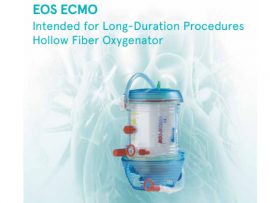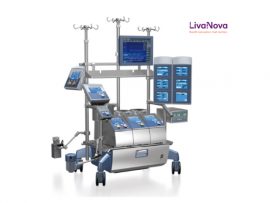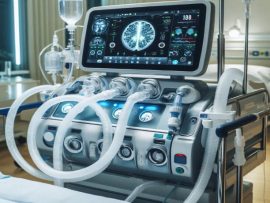Abstract Background Postoperative bleeding is associated with significant resource use and is an important contributor to other major adverse events in pediatric patients undergoing complex cardiac surgical procedures. Thromboelastography (TEG;..
WeiterlesenAbstract Background: The incidence of hyperlactatemia due to hypoperfusion during cardiopulmonary bypass (CPB) increases morbidity. Carbon dioxide production during CPB is one of the lactate production markers, in addition to..
WeiterlesenAbstract Background Thoracoabdominal normothermic (TA-NRP) has emerged as a powerful technique for optimizing from donation after circulatory death donors. Despite its rapid adoption, standardized guidelines for TA-NRP implementation are lacking, prompting the..
WeiterlesenAbstract Background: This study aims to assess the outcomes and complications of patients who received veno-arterial extracorporeal membrane oxygenation (VA-ECMO) and intra-aortic balloon pump (IABP) support after cardiac surgery at..
WeiterlesenAbstract Extracorporeal membrane oxygenation (ECMO) is a mechanical support treatment modality used in patients with refractory cardiac and/or pulmonary failure. Bleeding and thrombotic complications associated with ECMO are inherent concerns..
WeiterlesenAbstract A canonical view of the primary physiological function of myoglobin (Mb) is that it is an oxygen (O2) storage protein supporting mitochondrial oxidative phosphorylation, especially as the tissue O2 partial..
WeiterlesenAbstract Background Drug shortages are a frequent challenge in current clinical practice. Certain drugs (e.g., protamine) lack alternatives, and inadequate supplies can limit access to services. Conventional protamine dosing uses..
WeiterlesenAbstract Aim This study aimed to compile data on the effectiveness of music therapy for patients undergoing cardiothoracic surgery. Background After cardiac and thoracic surgery, patients often experience physiological and..
WeiterlesenAbstract Background Across the world, many systems have implemented extracorporeal cardiopulmonary resuscitation (ECPR) as a potential treatment strategy for patients in refractory cardiac arrest. To date, there are no universally..
WeiterlesenAbstract Background Team reflexivity and peer feedback in daily clinical work can improve patient safety. However, teams do not always engage in reflection after patient care. A reason could be..
WeiterlesenAbstract The application of venovenous (VV) extracorporeal membrane oxygenation (ECMO) has gained wide acceptance for the treatment of acute severe respiratory failure. Since no rat model of VV ECMO therapy..
WeiterlesenAbstract Objective Minimally invasive extracorporeal circulation has been shown to be non-inferior or even superior to conventional cardiopulmonary bypass circuits in isolated coronary artery bypass grafting, but there is little..
WeiterlesenAbstract Aim To examine the level of adherence to best-practice guidelines of interprofessional teams with acute care nurse practitioners (ACNPs) compared to interprofessional teams without ACNPs. Design A retrospective observational..
WeiterlesenAbstract Background Cardiac surgery with cardiopulmonary bypass (CPB) triggers pulmonary injury. In this trial we assessed the feasibility, safety, and efficacy of low frequency ventilation (LFV) during CPB in patients..
WeiterlesenAbstract Introduction The Protek Duo (PtD) dual lumen, single cannula was developed as a percutaneous system for temporary mechanical support, inserted through the internal jugular vein (IJ) for both atrial..
WeiterlesenAbstract Background:The study objective was to characterize compliance with Standardized Therapy after ECMO Program (STEP), an intentional discharge pathway for extracorporeal membrane oxygenation (ECMO) survivors in a US pediatric hospital. ..
WeiterlesenAbstract Background Unfractionated heparin, administered during venoarterial extracorporeal membrane oxygenation to prevent thromboembolic events, largely depends on plasma antithrombin for its antithrombotic effects. Decreased heparin responsiveness seems frequent on extracorporeal..
WeiterlesenAbstract Background The inflammatory response to cardiopulmonary bypass (CPB) in pediatric patients remains an unresolved challenge. Sanguineous CPB prime, composed of allogenic blood products, is one potentially important stimulus. This..
WeiterlesenAbstract OBJECTIVES: Continuous, therapeutic anticoagulation is the standard of care for patients on extracorporeal membrane oxygenation (ECMO). The risks of hemorrhage exacerbated by anticoagulation must be weighed with the thrombotic..
WeiterlesenAbstract Background Although serum bicarbonate is a reliable predictor of various disease complications, its relationship with postoperative delirium (POD) remains unclear. Our research aimed to assess the effect of baseline..
WeiterlesenAbstract Background Acute kidney injury (AKI) represents a significant post-cardiac surgery complication, particularly prevalent among individuals with pre-existing renal dysfunction. Chronic kidney disease (CKD) is frequently accompanied by persistent, low-grade..
WeiterlesenAbstract This nested case-control study identified broad dysregulation of the circulating proteome in neonates receiving postoperative extracorporeal membrane oxygenation support after congenital heart disease surgery, including differential responses in those..
WeiterlesenAbstract Over the past 10 years, there has been a rapid expansion in the use of extracorporeal membrane oxygenation (ECMO) in the care of patients with refractory cardiac or respiratory..
WeiterlesenAbstract BACKGROUND: Early detection of acute brain injury (ABI) at the bedside is critical in improving survival for patients with extracorporeal membrane oxygenation (ECMO) support. We aimed to examine the..
WeiterlesenAbstract Cardiac surgery-associated acute kidney injury (CSA-AKI) is a high-risk complication with well-recognized increased morbidity and mortality after cardiac surgery attributable in large part to cardiopulmonary bypass (CPB)-associated factors contributing..
WeiterlesenAbstract Background: Histidine-tryptophan-ketoglutarate (HTK) cardioplegia induces cardiac arrest through membrane hyperpolarization. Aortic valve pathology leads to pathophysiological changes in left ventricular vascularization that may prevent adequate cardioplegic distribution. The objective..
WeiterlesenAbstract Introduction Over the past 20 years, the Pediatric Cardiovascular Department at Penn State Health Children's Hospital and College of Medicine has been researching ways to improve the safety and..
WeiterlesenAbstract Background Infants undergoing ECMO may have elevated serum ferritin and iron levels, raising concerns about iron overload. Recent studies question the utility of these markers for acute vs. chronic..
WeiterlesenAbstract Nitric oxide (NO), a selective pulmonary vasodilator, can be delivered via conventional ICU and anesthesia machine ventilators. Anesthesia machines are designed for rebreathing of circulating gases, reducing volatile anesthetic..
WeiterlesenAbstract The declining birth rate and aging population are becoming increasingly serious social issues in Japan. In this report, we summarize the current congenital heart surgery and pediatric perfusion practices..
Weiterlesen




















